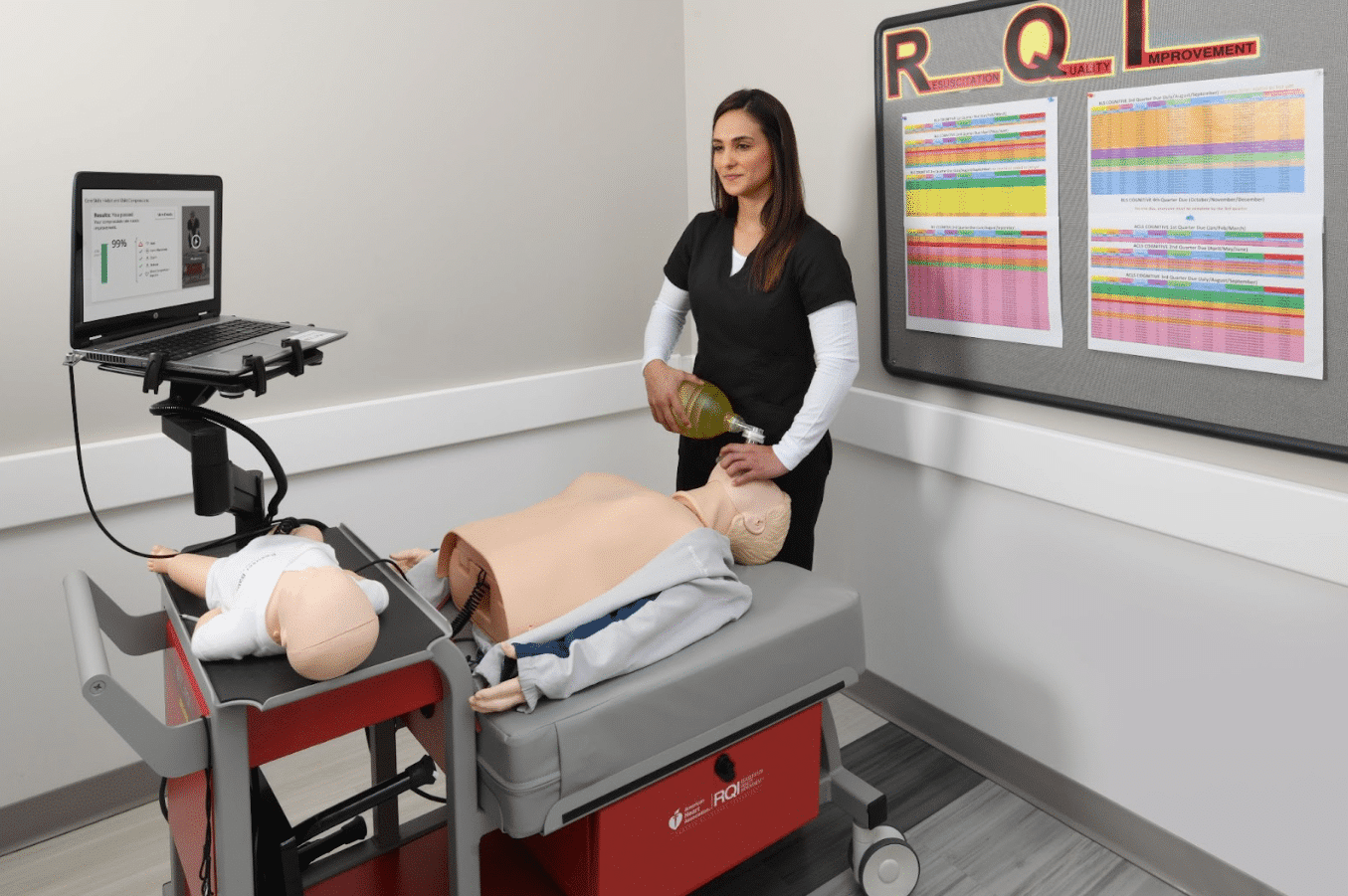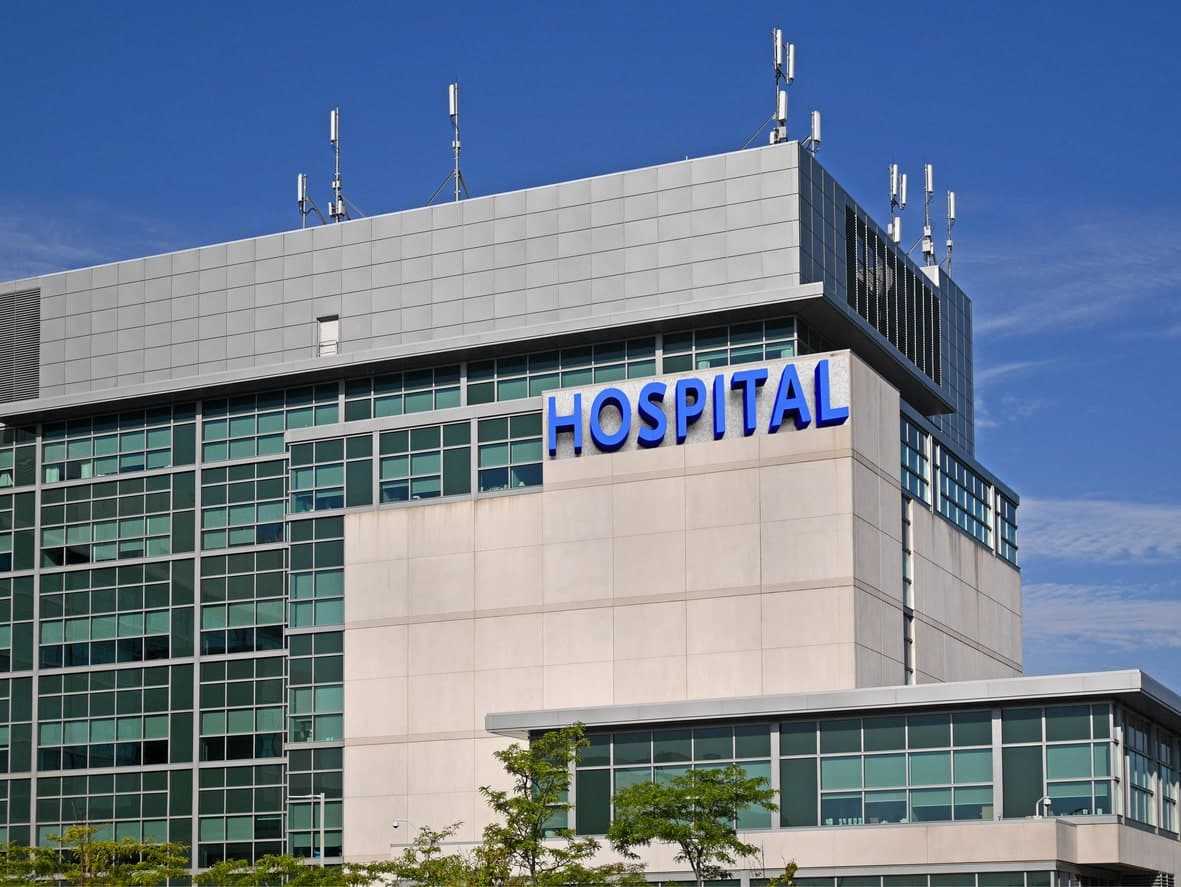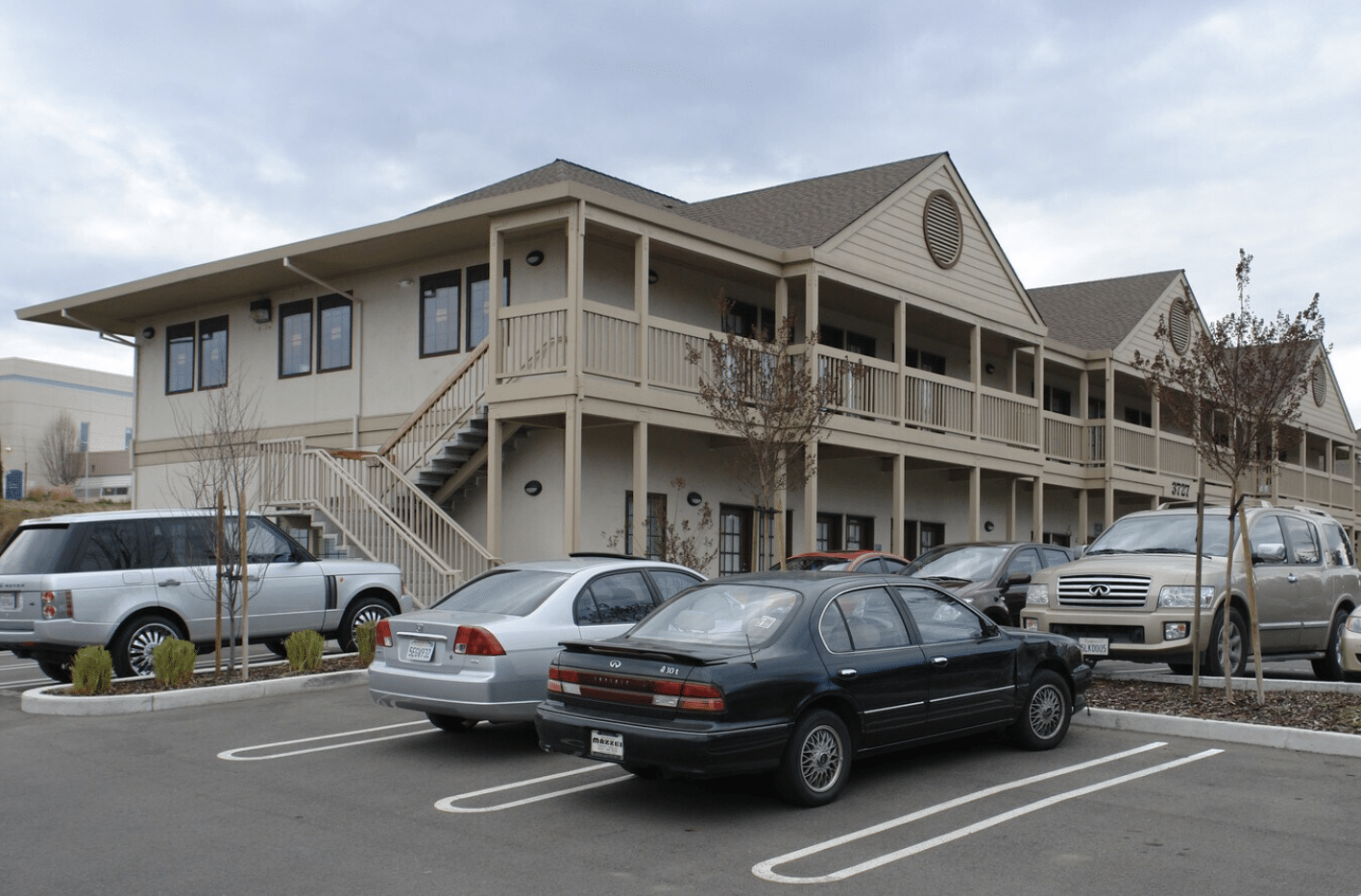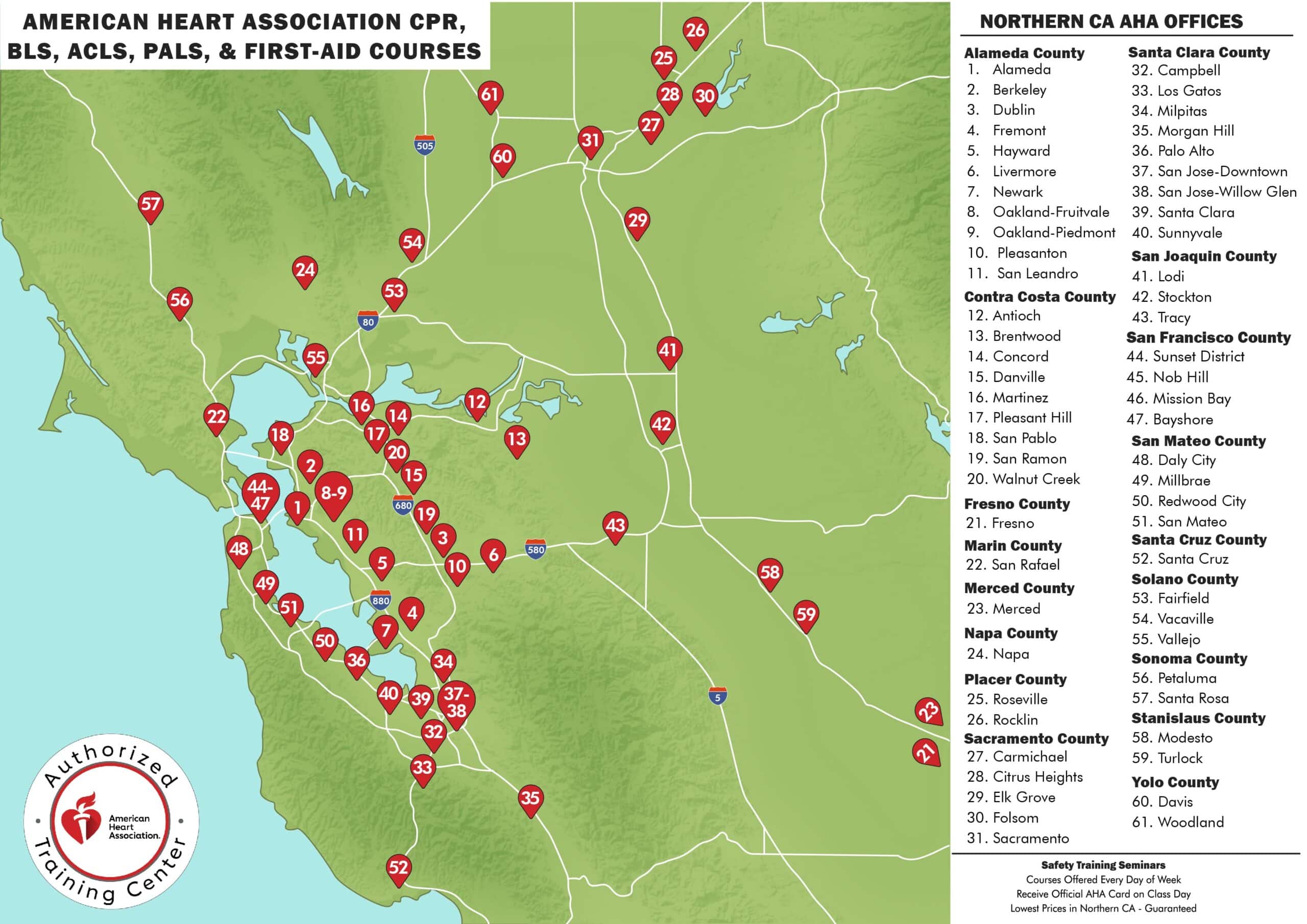
CPR Classes in Antioch
BLS, ACLS, PALS, CPR & First-aid Classes
American Heart Association Course Registration
Safety Training Seminars offers American Heart Association CPR, BLS, ACLS, and PALS courses in Antioch, CA. This office is close by the surrounding cities of Brentwood and Concord. If you live in Antioch, you can take a BLS, ACLS, or PALS course near you. We can teach CPR & First-aid classes at your location any day of the week. Ask us about our group discounts.
American Heart Association Course Registration
Safety Training Seminars offers American Heart Association CPR, BLS, ACLS, and PALS courses in Antioch, CA. This office is close by the surrounding cities of Brentwood and Concord. If you live in Antioch, you can take a BLS, ACLS, or PALS course near you. We can teach CPR & First-aid classes at your location any day of the week. Ask us about our group discounts.
What is American Heart Association RQI
The American Heart Association RQI (Resuscitation Quality Improvement) program is one of the most popular, modern, and efficient ways for medical and healthcare professionals to receive their official American Heart Association BLS, ACLS, and PALS certification cards.
Three Easy Steps
1. Take the American Heart Association online course at home (a few hours).
2. Arrive to one of our 45 local offices and practice with the VAM (voice assisted manikin).
3. Receive your certification card on the day of the class.

About American Heart Association RQI
Entry Instructions for Antioch CPR Classroom
Exploring the Hidden Gem of Antioch, California
Introduction
Nestled on the banks of the San Joaquin River, Antioch, California, is a city that often remains overshadowed by its more renowned neighbors in the Bay Area. However, this hidden gem holds a captivating blend of history, natural beauty, and modern amenities that make it a unique and intriguing destination for both residents and visitors. From its rich past to its promising future, Antioch offers a diverse range of attractions and experiences that are waiting to be discovered.
A Glimpse into Antioch’s History
Antioch’s history dates back to the mid-19th century when it was founded as a small mining town. The discovery of coal and the establishment of the Southern Pacific Railroad turned this once-tiny settlement into a bustling hub of economic activity. The Black Diamond Mines Regional Preserve, a testament to its mining heritage, now stands as a popular historical park where visitors can explore old mining tunnels, learn about the lives of coal miners, and immerse themselves in the past.
Natural Beauty and Outdoor Recreation
One of the defining features of Antioch is its stunning natural beauty. The city boasts over 11 miles of scenic waterfront along the San Joaquin River, offering ample opportunities for outdoor enthusiasts to indulge in activities like boating, fishing, kayaking, and picnicking. The Dow Wetlands Wildlife Habitat Preserve is a haven for birdwatchers and nature lovers, where various species of birds and wildlife thrive in their natural habitats.
For those seeking hiking adventures, the Black Diamond Mines Regional Preserve extends beyond history into a realm of rolling hills, diverse flora, and hiking trails that offer breathtaking panoramic views of the surrounding landscape. The 2,209-acre preserve is a playground for outdoor enthusiasts, providing a chance to reconnect with nature and embark on explorations that transport them back in time.
Cultural Enrichment and Artistic Expression
Antioch’s cultural scene is alive and thriving, with local artists and performers contributing to a vibrant arts community. The El Campanil Theatre, a historic landmark dating back to 1928, hosts a variety of concerts, plays, and film screenings, providing residents and visitors with opportunities to immerse themselves in the world of performing arts. The Antioch Historical Society Museum is another treasure trove of local history, housing artifacts, photographs, and documents that chronicle the city’s evolution.
Community Spirit and Festive Celebrations
The spirit of community is palpable in Antioch, where residents come together to celebrate various events and festivals throughout the year. The Antioch Rivertown Jamboree, a lively street fair featuring live music, food vendors, and local artisans, showcases the city’s vibrant culture and brings people from all walks of life together. The Fourth of July Parade and Fireworks Spectacular is a highlight, drawing crowds for a patriotic celebration that lights up the night sky.
Antioch’s Promising Future
As Antioch embraces the 21st century, the city is committed to nurturing its potential and enhancing the quality of life for its residents. Ongoing urban revitalization efforts are transforming downtown Antioch into a modern and vibrant hub, complete with new shopping districts, dining establishments, and cultural spaces.
The city’s emphasis on education is evident in its dedication to providing top-notch educational facilities, ensuring that the younger generation has access to quality learning environments. Furthermore, Antioch’s strategic location offers easy access to both the Bay Area and the Central Valley, making it an ideal residence for those seeking a balance between urban convenience and suburban tranquility.
Conclusion
Antioch, California, might not be the most famous city in the Bay Area, but it certainly possesses a unique charm and character that make it a destination worth exploring. From its fascinating history and abundant natural beauty to its vibrant arts scene and strong sense of community, Antioch has much to offer both residents and visitors. As this hidden gem continues to evolve and grow, it is poised to shine even brighter on the map of California’s captivating cities.
Life-Saving Skills: Exploring CPR, BLS, ACLS, and PALS Classes
In the realm of emergency medical care, few skills are as crucial as Cardio-Pulmonary Resuscitation (CPR) and Advanced Cardiac Life Support (ACLS), Basic Life Support (BLS), and Pediatric Advanced Life Support (PALS) techniques. These life-saving techniques form the backbone of first response and medical intervention, often making the difference between life and death in critical situations. Let’s delve into the significance of each of these classes and their role in maintaining public health and safety.
Cardio-Pulmonary Resuscitation (CPR): CPR is a fundamental life-saving technique that can be administered by trained individuals to sustain blood circulation and provide artificial respiration when a person’s heart has stopped beating. CPR involves a combination of chest compressions and rescue breaths, aimed at keeping oxygenated blood flowing to vital organs until professional medical help arrives. CPR classes provide participants with the skills to recognize cardiac arrest, perform effective chest compressions, and deliver rescue breaths. These classes are vital for both medical professionals and laypersons, empowering them to respond swiftly and effectively in emergencies.
Basic Life Support (BLS): BLS takes CPR skills to the next level by incorporating additional techniques and equipment usage. BLS classes are designed for healthcare providers, including doctors, nurses, paramedics, and emergency medical technicians (EMTs). Participants learn how to assess a patient’s condition, deliver high-quality CPR, and use automated external defibrillators (AEDs) to restore a regular heartbeat. BLS training emphasizes teamwork, effective communication, and quick decision-making to optimize patient outcomes during cardiac emergencies.
Advanced Cardiac Life Support (ACLS): ACLS is an advanced course tailored for healthcare professionals who are involved in the management of cardiac arrest and other cardiovascular emergencies. ACLS builds upon the foundation of BLS and focuses on identifying and treating potentially life-threatening conditions such as stroke, myocardial infarction, and arrhythmias. Participants learn to interpret electrocardiograms (ECGs), administer medications, and perform advanced airway management. ACLS classes equip medical personnel with the skills to respond confidently to complex cardiac scenarios, ensuring comprehensive care for critically ill patients.
Pediatric Advanced Life Support (PALS): PALS training is geared towards healthcare providers who care for infants and children during emergencies. Pediatric patients have unique physiological needs, making PALS classes essential for those working in pediatrics, emergency medicine, and intensive care. PALS courses cover topics such as pediatric assessment, effective respiratory support, and the management of pediatric cardiac arrest. Participants gain the knowledge and skills necessary to provide specialized care and interventions that can make a critical difference in the outcomes of pediatric emergencies.
NRP, or Neonatal Resuscitation Program, is a critical medical initiative that focuses on saving newborns who struggle to breathe at birth. This specialized training equips healthcare providers with the skills to assess and manage respiratory distress in infants. NRP emphasizes a systematic approach, teaching effective ventilation techniques and chest compressions if needed. Regularly updated guidelines ensure that participants stay current with the best practices in neonatal care. By enhancing healthcare professionals’ abilities to respond swiftly and effectively to newborn respiratory challenges, NRP plays a vital role in improving infant survival rates and ensuring a healthier start to life.
First-aid classes offer indispensable life skills that empower individuals to respond confidently in emergencies. These structured courses cover a spectrum of situations, from minor injuries to critical incidents, teaching participants how to provide immediate care before professional help arrives. Participants learn to administer CPR, treat wounds, manage choking, and address common health crises. Hands-on training fosters essential skills and boosts confidence, enabling swift and effective action in times of need. First-aid classes are invaluable for workplaces, homes, and communities, creating a network of capable first responders. Mastering these skills not only saves lives but also fosters a safer and more prepared society.
Incorporating these life-saving techniques into healthcare systems, workplaces, and communities can significantly enhance the response to medical emergencies. Quick and effective interventions provided by individuals trained in CPR, BLS, ACLS, and PALS can stabilize patients and improve their chances of survival before professional medical assistance arrives. Moreover, these classes promote a culture of preparedness, empowering individuals to step forward and take action when faced with emergency situations.
In conclusion, American Heart Association CPR, BLS, ACLS, and PALS classes play an indispensable role in equipping individuals with the skills and knowledge needed to respond effectively to various medical emergencies. These courses bridge the gap between bystander assistance and professional medical care, ultimately contributing to improved patient outcomes and increased survival rates. By investing in these life-saving classes, individuals and healthcare professionals alike become vital links in the chain of survival, ensuring that timely and appropriate care is delivered when it matters most.
Our Blog

Hospitals & Medical Centers in Antioch, CA
Antioch, California, combines old charm with modern growth and has a strong healthcare community for both locals and people from nearby areas. With both advanced

Psychological Recovery for CPR Survivors
Cardiopulmonary resuscitation (CPR) is a life-saving technique that has been known to save countless lives during cardiac emergencies. It is a first-line response that aims

The Science Behind Effective Cardiopulmonary Resuscitation (CPR)
Introduction Cardiopulmonary resuscitation, better known as CPR, is a crucial emergency procedure that can mean the difference between life and death. This vital process, performed



